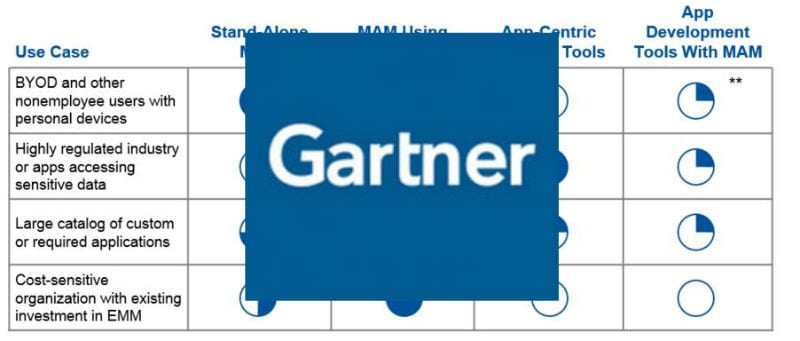Gartner’s Latest Report Recognizes MAM’s Place in the Mobility Management Market

Gartner
Gartner has just released a new report called Market Guide for Mobile Application Management, that breaks down the different deployments of MAM and how they fit into the enterprise. As I stated yesterday, there is a very distinct need for mobile application management, along with the need for mobile device management, BYOD, IAM and MCM. What Gartner is recognizing in this report is that the MAM category can’t is still very scattered and calls into question whether it’s better to have your MAM solution included in your enterprise mobility solution, or is it better as a standalone solution.
Mobile application management is, in a way, an alternative to mobile device management. The administrator has control over certain apps on the device instead of the device itself. This leads to easier BYOD deployment by separating personal apps from corporate apps. MAM solutions also integrate with public and private app stares while controlling the setting and policies of apps or groups of apps. Most EMM suites do contain MAM but the concern is that with the rapidly growing number of enterprise apps, is the MAM in EMM enough?
According to the report there are four types of MAM solutions: stand -alone MAM tools, App Management using EMM, app-centric security tools and app management using MADP/development tools. Gartner lists the prominent vendors in each category (see report for full list).
No Gartner report is complete without a graphic and this is no exception. However the graphic for this report is much different than the Magic Quadrant or even the Gartner Critical Capabilities charts. This chart takes the four approaches of MAM and rates them based on four use cases. These use cases are: BYOD and other non employee users with personal devices, highly regulated industry or apps accessing sensitive data, large catalog of custom or required applications, and cost-sensitive organization with existing investment. Each of theses approaches is evaluated using a circle that is filled in to varying degrees; full, three-quarters, half, one quarter and empty.
The results are a little more telling then one may think based on how Gartner historically ranks and evaluates solutions. Stand-alone MAM and MAM using EMM both have the highest marks across the board, but they are strong in different use cases. Stand-alone is the best overall in the BYOD catagory and is either a capable or capable but limited solution in all the other cases. MAM using EMM is the strongest by a long shot in the cost-sensative organization with existing investment in EMM (which makes sense considering). App-centric security tools and app development tools with MAM don’t perform well in more than one (or in the later’s case any) category.
What this result tells me is there is an actual winner here in my eyes and that would be MAM using EMM. Some may disagree, but an MAM solution needs to be compatible and effective with an EMM solution. The only way I could have seen another approach as superior is if it outperformed MAM using EMM hands down. Since Stand-alone is just as good in this report it will entirely depend on what industry and purpose you are using the solutions for.





















